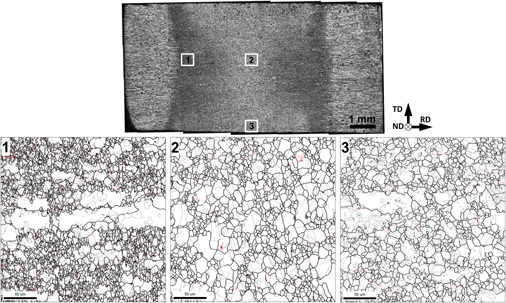Crossref Citations
This article has been cited by the following publications. This list is generated based on data provided by
Crossref.
Ilyasov, Rafis
Sitdikov, Oleg
Avtokratova, Elena
and
Markushev, Michael
2015.
Microstructure Development in Cold-Rolled Al-Mg-Sc-Zr Alloy under Furnace and Short Electric Pulse Annealing.
Materials Science Forum,
Vol. 830-831,
Issue. ,
p.
399.
Li, Ning
Yu, Haiping
Xu, Zhu
Fan, Zhisong
and
Liu, Lin
2016.
Electromagnetic forming facilitates the transition of deformation mechanism in 5052 aluminum alloy.
Materials Science and Engineering: A,
Vol. 673,
Issue. ,
p.
222.
Konkova, T.
Valeev, I.
Mironov, S.
Korznikov, A.
Korznikova, G.
Myshlyaev, M.M.
and
Semiatin, S.L.
2016.
Microstructure response of cryogenically-rolled Cu–30Zn brass to electric-current pulsing.
Journal of Alloys and Compounds,
Vol. 659,
Issue. ,
p.
184.
Huang, Ke
Cayron, Cyril
and
Logé, Roland E.
2017.
The surprising influence of continuous alternating electric current on recrystallization behaviour of a cold-rolled Aluminium alloy.
Materials Characterization,
Vol. 129,
Issue. ,
p.
121.
Wang, Shubo
Jia, Hailong
and
Li, Yanjun
2019.
Accelerated recrystallization by electric current flash heating in cold-rolled Al-5Cu alloy under the influence of concurrent precipitation.
Journal of Alloys and Compounds,
Vol. 811,
Issue. ,
p.
151891.
Valeev, Irshat
Valeeva, Aygul
Ilyasov, Rafis
Sitdikov, Oleg
and
Markushev, Michael
2019.
Structure and hardness of cold-rolled nickel after single and multiple electric pulse treatment.
Letters on Materials,
Vol. 9,
Issue. 4,
p.
447.
Hutchinson, Bevis
2020.
Critical Assessment 39: Effects of applied fields during annealing of metals – a review.
Materials Science and Technology,
Vol. 36,
Issue. 11,
p.
1125.
Ilyasov, R R
Valeeva, A Kh
Valeev, I Sh
Sitdikov, O Sh
and
Markushev, M V
2020.
Effect of electric pulse treatment on the structure and hardness of nickel deformed at room and liquid nitrogen temperatures.
IOP Conference Series: Materials Science and Engineering,
Vol. 1008,
Issue. 1,
p.
012006.
Markushev, Michael
Ilyasov, Rafis
Krymskiy, Stanislav
Valeev, Irshat
and
Sitdikov, Oleg
2021.
Structue and strength of fine-grain copper after cryorolling and single electrо-pulsing of different capacity.
Letters on Materials,
Vol. 11,
Issue. 4,
p.
491.
Valeev, Irshat
Valeeva, Aygul
Ilyasov, Rafis
Avtokratova, Elena
Krymskiy, Stanislav
Sitdikov, Oleg
and
Markushev, Michael
2021.
Influence of electric pulse treatment on structure and hardness of cryorolled aluminum.
Letters on Materials,
Vol. 11,
Issue. 3,
p.
351.
Markushev, Michael
Valeev, Irshat
Avtokratova, Elena
Ilyasov, Rafis
Valeeva, Aygul
Krimsky, Stanislav
and
Sitdikov, Oleg
2023.
Effect of high-dense electropulsing with different energies on the structure and strength of nickel cryorolled to different strains.
Letters on Materials,
Vol. 13,
Issue. 2,
p.
126.
Luo, Fang
Jiang, Xiaosong
Sun, Hongliang
Fang, Yongjian
Zhang, Yali
and
Shu, Rui
2023.
Strengthening Mechanisms and Thermal Models of Chemically Incompatible Metals (Mo/W–Cu): A Review.
Advanced Engineering Materials,
Vol. 25,
Issue. 12,





